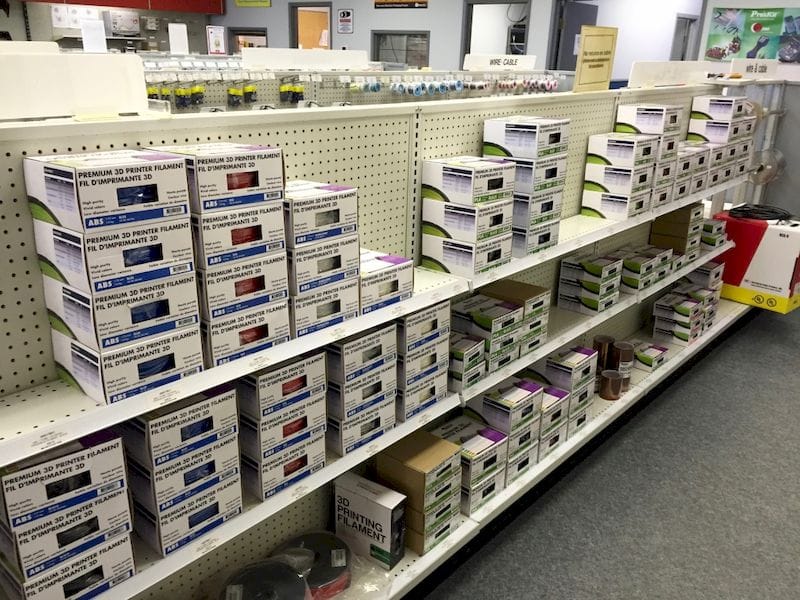
There are now more ways to acquire 3D printer filament, but what is the best way to do so?
Years ago, those with desktop 3D printers had only one way to acquire the necessary materials to operate their device: ordering online, usually from the manufacturer of the 3D printer.
That capability persists today, with dozens, perhaps even hundreds of online outlets marketing all manner of 3D printer filament and now liquid photopolymer resins for that type of 3D printer.
But one effect I’m seeing more of is the appearance of 3D printing materials in physical retail stores in major metropolitan areas.
I’ve been in such a habit of ordering online that the sight of 3D printing materials in an actual store is a bit jarring. The image above is from a local electronics supply store that for some reason decided to carry a line of 3D printer filaments.
My immediate reaction was to inspect the inventory to see what was on display. In this case I found the materials were sourced from one generic manufacturer that I honestly hadn’t heard of before. But there was a reasonable but basic selection of 1.75 and 2.85mm filaments in the primary colors and materials: PLA, ABS and PETG. And they were available at good prices with NO shipping costs, obviously.
This scenario is being played out in various retail outlets across the world today, with 3D printing materials suddenly appearing on store shelves.
One problem with the retail purchase scenario is that you likely have very limited choice, perhaps not in colors, but in material brands. In my case, only one generic brand was present. But what if I wanted to buy, say, some colorFabb? Or PolyMaker? Or eSun?
The availability of those brands depends on the company making retail deals with these outlets, and that’s something not all producers are doing. Some continue to rely solely on online sales, while others prefer to attract regional resellers for simplicity in expansion. Few seem to be pursuing retail deals.
One that is doing so is PolyMaker, who have recently signed an agreement with Microcenter to provide their branded products at several Microcenter stores in the USA. This to me is good news, as it provides more choice for buyers.
Should one buy 3D printing materials in this way? I think the answer depends on how you feel about several aspects. Choice, we’ve discussed. If you want particular brands of materials and they are not available at your local outlets, well, I suppose there’s not much more to discuss.
However, there are other considerations.
The most important one is time. If you find yourself suddenly short of material, you can simply go and get some. The time to do so is often measured in hours or in some cases only minutes if the retail outlet is nearby. This is quite different from waiting for a day or two (or three or four or more) from an online outlet.
Cost is another consideration. Ordering online can generate costs in addition to the product itself, and can include shipping fees that might be high if ordering from distant sources. You might also have to pay customs duties if the material crosses a border – and possibly brokerage fees as well. There are hidden costs to ordering online.
On the other hand, you may be focused on particular brands for other reasons. A company, for example, might insist on using only the manufacturer’s materials to ensure print quality – or at least have someone to clearly blame if things go wrong.
But as 3D printing becomes more widespread, we will likely see an increasing amount of material appear in different retail stores worldwide, possibly putting some pressure on online outlets.

